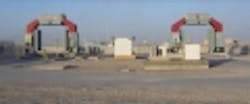DOD looks to improve geospatial accuracy of airborne video with technology from Charles River Analytics
Posted by John McHaleCAMBRIDGE, Mass., 27 Nov. 2010. Charles River Analytics Inc. won a contract to develop RELIANCE (Registration of EO and LIDAR using an Interoperability Architecture for Net-Centric Environments) for the U.S. Department of Defense (DOD). RELIANCE accurately maps video streams from multiple airborne sensors onto a common view of the battlefield in real time, to overcome the so-called "soda straw syndrome" caused by the limited field of view of most current full motion video (FMV) sensors. The software renders live video from FMV sensors onto a virtual globe with 3D terrain, and annotates the video with geographic information system (GIS) layers. "Our system is similar to Google Earth, but can display live video painted onto 3D terrain," says Daniel Gutchess, senior software engineer at Charles River. "Unlike static satellite imagery, which may be a year old or more, RELIANCE provides an up-to-the-second view of the Earth. It allows the video to be marked up with geospatial information, such as labeled locations of interest from a GIS database. It also lets the user zoom out beyond the soda straw and visualize information in the wider context of locations and events outside the video camera's current field of view." The system is based on an open architecture, enabling its 3D map display to be augmented with information from other sensors and systems. By precisely mapping video to ground coordinates, RELIANCE can substantially improve the ability to collect geospatially accurate intelligence. "The increased accuracy will ensure, for example, that the correct building is identified in a densely-populated urban area," Gutchess says. "As a result, we believe the technology has the potential to significantly reduce collateral damage and friendly fire incidents." RELIANCE's georegistration technology can also be applied to a number of non-military applications where accurate geolocation is required and imaging is used to track or observe objects on the ground, such as emergency operations, law enforcement, commercial mapping and surveying, agriculture, and environmental studies."We are particularly excited about tackling this geospatial accuracy issue because this is such an important problem for so many users," says Magnús Snorrason, principal scientist, sensor processing, and networking at Charles River Analytics. "The proliferation of airborne video sensors is of little use if there's no way to tell exactly where the video was taken. The goal of RELIANCE is to solve spatial inaccuracy issues in a way that is completely transparent to the user."The DOD-sponsored contract is valued at more than $1 million, plus options for enhancements.

